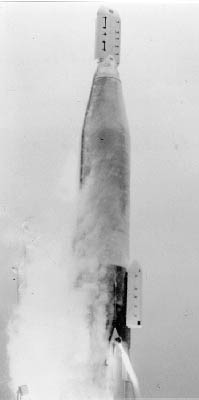Thank you very much for visiting Gunter's Space Page. I hope that this site is useful and informative for you.
If you appreciate the information provided on this site, please consider supporting my work by making a simple and secure donation via PayPal. Please help to run the website and keep everything free of charge. Thank you very much.
Atlas-D OV1

Atlas-D OV1 (single, side mounted) (OV1 1) [USAF] |

Atlas-D OV1 (dual, top mounted) (OV1 9, OV1 10) [USAF] |

Atlas-D OV1 (dual, top mounted, with side mounted suborbital pod) (OV1 7, OV1 8) [USAF] |

Atlas-D OV1 (triple, 2 top mounted, 1 side mounted) (OV1 11, OV1 12 and OV1 86) [USAF] |
The Atlas-D OV1 was unique system to launch small research satellites, where each satellite had its own independent OV1 upper stage.
The original intent of the OV1 (Orbiting Vehicle 1) system was, to provide orbital launch opportunities during regular suborbital Atlas-D ICBM test flights. As Atlas-D provided the opportunity to fly side mounted research pods, the OV1 system was built around such a pod. The pod, called ARS (Atlas Retained Structure) featured a side-mounted door, to deploy the upper stage satellite combination.
The Convair (General Dynamics) built OV1 consisted of a X-258 (Altair-2) solid rocket motor and an hydrogen-peroxide attitude control system with 12 nozzles inherited from the Scout rocket. The attitude control system performed separation from the Atlas, oriented the payload stack and provided stabilization, when the solid motor injected the satellite into orbit.
In fact, only the first two missions flew piggy-back on ICBM launches, as it became apparent, that the satellites mostly hat orbital needs, that could not be satisfied on suborbital piggy-back launches. Therefore a new dual launch enclosure for two ARS was designed to fit in the place of the reentry vehicle. This allowed dual launches with each satellite possessing its own individual upper stage. As the side mount position of the Atlas-D was still available, these launches could also feature an secondary suborbital experiments pod or even a third side-mounted ARS dispenser.
This combination was replaced by the Atlas-F OV1 combination, which provided more payload volume.
| Version | Stage 1 | Stage 2 |
|---|---|---|
| Atlas-D OV1 | Atlas-D / MA-2 | OV1 / X-258 (Altair-2) |
| Performance (kg) | LEO | LPEO | SSO | GTO | GEO | MolO | IP |
|---|---|---|---|---|---|---|---|
| Atlas-D OV1 (each OV1-PM) | - | 141 | - | - | - | - |
Nr TNr Vehicle Serial Conf Date LS Payload
236 1 Atlas-D OV1 172D 1S 21.01.1965 F Va 576B3 OV1 1 / ABRES MTV-1 * 251 2 Atlas-D OV1 68D 1S 28.05.1965 F Va ABRES-B3 OV1 3 / Mk.3 * 266 3 Atlas-D OV1 34D 2TP 05.10.1965 Va ABRES-B3 OV1 2 / OV1-Dummy * / SSP 29 * 280 4 Atlas-D OV1 (2×) 72D 2TP 30.03.1966 Va ABRES-B3 OV1 4 / OV1 5 (BORE) / SSP 28 * 298 5 Atlas-D OV1 (2×) 58D 2TP 14.07.1966 P Va ABRES-B3 OV1 7 / PASCOMSAT (OV1 8) / NC20.189 * 316 6 Atlas-D OV1 (2×) 89D 2T 11.12.1966 Va ABRES-B3 OV1 9 / OV1 10 338 7 Atlas-D OV1 (3×) 92D 2T1S 27.07.1967 P Va ABRES-B3 OV1 11 / OV1 12 (FARO) / OV1 86 Versions: 1S = 1 side mounted OV1, 1 top mounted reentry vehicle 2T = 2 top mounted OV1 2TP = 2 top mounted OV1, 1 side mounted suborbital pod 2T1S = 2 top mounted OV1, 1 side mounted OV1 Failures: 1: separation mechanism failed to release the satellite from the launch vehicle 2: Atlas exploded after 2 minutes of flight 5: OV1 7 payload door jammed, solid rocket motor failed 7: OV1 11 failed to separate from the launch vehicle Launch sites: Va = Vandenberg Air Force Base, California, USA
References:
- J. W. Powell and G. R. Richards, “The Orbiting Vehicle series of satellites”, Journal of the British Interplanetary Society, Volume 40, pp.417-426, 1987.
- Jos Heyman in MilSatMagazine: Intel... The Orbiting Vehicle Series (OV1)
- Directory of U.S. Military Rockets and Missiles: Orbiting Vehicle (OV)
